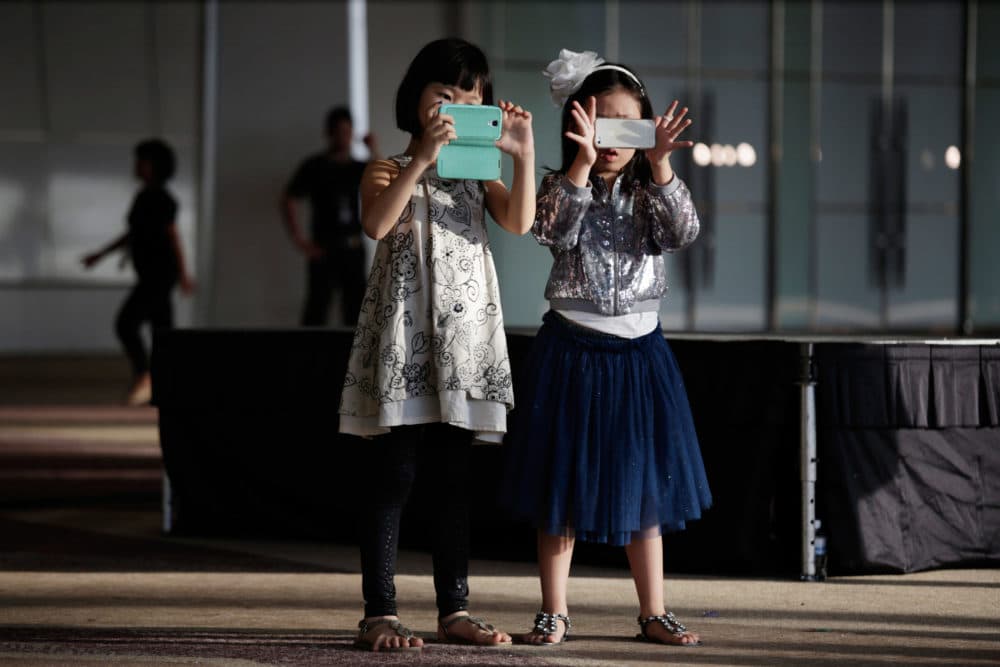Advertisement
Pandemic Life Includes A Lot of Screen Time For Kids. Is It Time To Cut Back?

Children across the country have been trying to do school on cell phones, tablets or laptops since last year.
Those screens usually don't go dark when class ends. For both adults and kids, the pandemic has exposed everyone to a tremendous amount of screen time.
Dr. Jenny Radesky, a developmental-behavioral pediatrician at the University of Michigan Medical School and lead author of “Media and Young Minds,” says she’s noticed a shift in the number of hours kids are piling up online. The “enormous increase” is supported by App Store and Roblox data, she says.
Kids’ screen time, by some estimates, is up 50% to 60% in the pandemic. They’ve picked up new habits in the meantime, potentially using technology to run from problems or numb emotional feelings. With the digital world at our fingertips, it’s become an easy coping mechanism to turn to, Radesky says.
Addiction is not the right word to describe the situation, she says, because that places the onus on the individual child instead of the “digital environment that is actually shaping a lot of those engagement behaviors.”
However “our very pleasurable digital environment” can induce a similar brain mechanism that Radesky says gamblers call “a subjective shift,” a space where you can ignore any outside stress.
Take kids’ YouTube channels for example, she says, where parents film their children opening fancy packages or trying on a brand new Disney princess dress. “This isn't like high-quality, nutritious content for kids,” she says. “It's mostly just pleasure seeking and escapism.”
Everyone needs a bit of an escape after a difficult year, she acknowledges, but many of these videos and websites are designed to persuade kids’ eyes to stick to the screen, she says.
“Technology that's designed all based on ad revenue and keeping kids' eyeballs on longer, that's usually the technology that's not supporting our best interest,” she says.
Radesky says it’s a good idea for parents to start thinking about weaning their children off these screens as in-person learning approaches. But for the most part, she predicts kids will naturally gravitate away from their devices as they experience more opportunities to play sports, go back to music lessons and head to school.
Advertisement
If your child is struggling with motivation to do anything offline or you find yourself arguing with them constantly about putting down the video games, do not hesitate to plan a family meeting to walk through the problem, she says.
If your child is YouTube-obsessed, try utilizing the timer functions on YouTube Kids. Other streaming platforms have “stoppage cues,” she says, to remind your child to pause and reflect on how long they’ve been glued to the screen.
Radesky suggests instead of always relying on warning messages or timers, try having kids self-regulate themselves. Together, plan out how much screen time they’ll have in one sitting.
“I sometimes say to my kids, ‘OK, if you can turn it off by yourself, you can have the same amount of time tomorrow,’ because I want them to self regulate their media use and show me it's not going to be a ridiculous battle every time,” she says.
As a result of the pandemic, kids got even greater access to the online world through school-issued laptops. Radesky, who has two children ages 7 and 11, both were initially bright-eyed about their new technology for school.
But after seeing her kids attached to YouTube and video games, she used the school’s device monitoring company to block certain websites and enabled Wi-Fi restrictions during certain times of day.
Last year’s swift jump to virtual learning “was a rapid introduction to much more technology than many of us raising young kids were ready for,” she says.
Plus, screens are here to stay. Digital devices are embedded into childrens’ lives earlier and earlier. Radesky says while there are worthwhile concerns about kids’ screen time, some blanket worries are overblown.
Parents should focus their concerns on whether screens are impacting kids’ sleep and outdoor exercise, for example. She encourages parents to get involved with their kids online, such as joining in on the magical fun of Roblox and Minecraft universes or co-viewing videos with them to generate a thought-provoking discussion afterward.
Julia Corcoran produced and edited this interview for broadcast with Todd Mundt. Serena McMahon adapted it for the web.
This segment aired on March 18, 2021.

